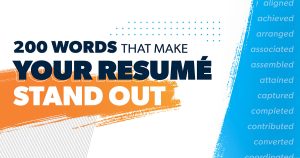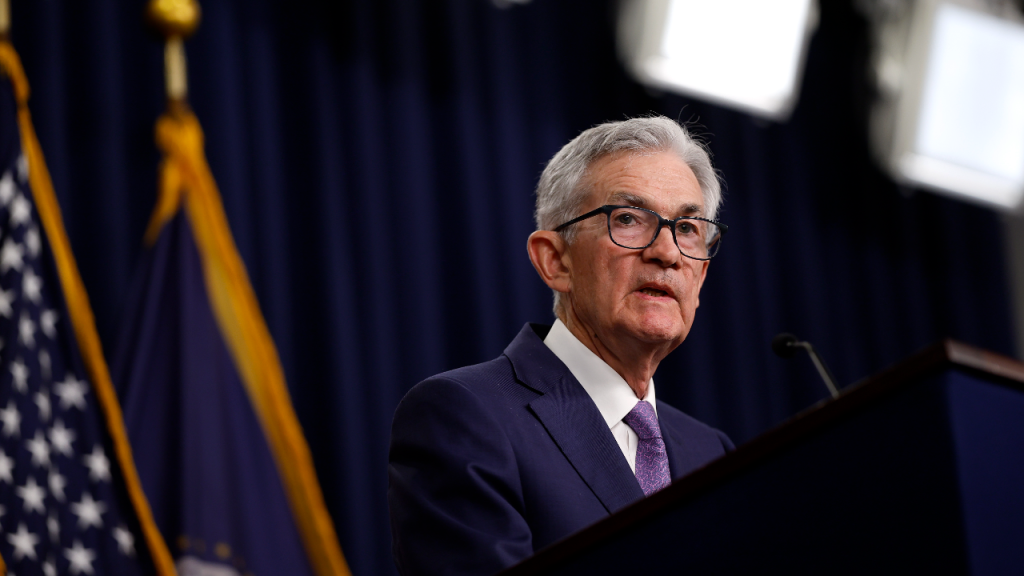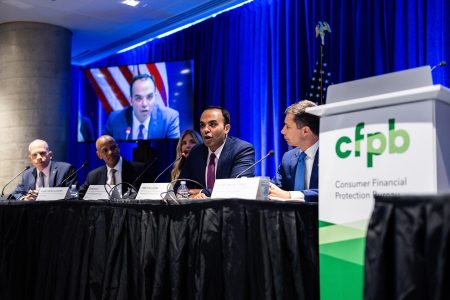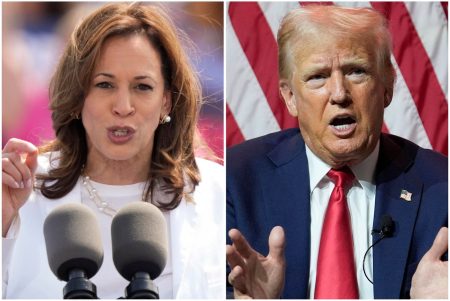The Federal Reserve left interest rates unchanged but acknowledged that inflation is improving and the unemployment rate has been edging up — two prerequisites that could pave the way for a rate cut in upcoming months.
The news means that the U.S. central bank’s Federal Open Market Committee (FOMC) will, for now, be keeping its key benchmark borrowing cost in its current target range of 5.25-5.5 percent, a level not seen since early 2001. Each Fed decision ripples through consumers’ pocketbooks. So long as the Fed’s federal funds rate remains historically elevated, so will mortgage rates, auto loans, credit cards, savings yields and more.
“The economic outlook is uncertain, and the committee remains highly attentive to inflation risks,” officials wrote in their post-meeting statement. The FOMC “does not expect it will be appropriate to reduce the target range until it has gained greater confidence that inflation is moving sustainably toward 2 percent.”
Consumers have been paying the price for the Fed’s decisions long before officials started raising interest rates. Believing a post-pandemic burst in prices was only temporary, Fed policymakers back in 2021 kept interest rates at record-low levels to give the U.S. economy more time to heal.
The oversight contributed to the worst inflation crisis in 40 years, impacting the cost of items consumers both want and need — from vacations and meals out to groceries, gasoline, utilities and housing. The Fed matched that crisis with an equally historic policy response. Not since the 1980s have officials lifted interest rates a whopping 5.25 percentage points in the span of just a year and a half.
The medicine appears to be working. Inflation, at least by the Fed’s preferred gauge, remains only half a percentage point above officials’ 2 percent target — down from a peak of 7.1 percent in 2022. Yet, unemployment is also climbing, most recently topping 4.1 percent for the first time since November 2021.
Fed Chair Jerome Powell has said that waiting to cut interest rates until inflation officially retreats to 2 percent raises the risk that they end up behind the curve. Economists and investors broadly expect that policymakers could cut interest rates for the first time since the coronavirus pandemic began in 2020 by its next gathering in September.
“The Fed has teed things up nicely for a September rate cut – as long as the inflation data cooperate,” says Greg McBride, CFA, Bankrate chief financial analyst. “The escape hatch from cutting rates is if inflation doesn’t continue to demonstrate consistent movement toward the 2 percent target.”
The Fed’s interest rate decision: What it means for you
Savers
It’s been the best time to be a saver in over a decade. At the start of 2022, the nation’s top-yielding online savings account was offering a 0.55 percent annual percentage yield (APY), a look back at historic Bankrate data shows. Today, the best account on the market is paying 5.45 percent, the highest since 2007, according to Bankrate.
It’s a market-like return with minimal risk, so long as a depositor selects an account with FDIC insurance. A $10,000 balance in an account with a 0.55 percent APY would yield a saver just $55 in a year, Bankrate’s savings calculator shows. With a yield of 5 percent, those earnings rise to $500 annually.
Yields could drift lower once the Fed starts cutting interest rates, but what matters most is whether depositors can beat inflation. Case in point: The top-yielding bank in March 2023 offered 5.02 percent APY, but that barely broke even with the growing cost of living. Prices rose 5 percent from a year ago in the month, Bureau of Labor Statistics data shows.
As of July 31, all of Bankrate’s top 10 savings accounts are outpacing inflation, Bankrate’s rankings show.
A high-yield savings account with limited withdrawal stipulations can be a good home for your emergency fund. Experts typically recommend consumers reserve anywhere between six to nine months’ worth of expenses for a rainy day.
If you already have enough liquid cash, you might be looking for opportunities to preserve those higher yields for longer. Certificates of deposit (CDs) offer savers a fixed rate of return for locking away their cash for a set number of years (or sometimes, months). Currently, the top-yielding 5-year CD is offering 4.5 percent APY, while the best 2-year CD is paying 4.81 percent. That could be a competitive yield by the time that product reaches maturity, with the Fed expecting to take interest rates back to 3-3.25 percent by 2026, its current projections show.
Those offers, however, will only start to edge lower once the Fed clearly looks like it’s going to cut interest rates.
Borrowers
One rate cut from the Fed won’t be enough to take away the pain of the costliest credit card rates ever. Consumers with high-interest debt are still recommended to prioritize paying off their balances as quickly as possible.
The best balance-transfer cards on the market currently start Americans off with a 0 percent intro annual percentage rate (APR) for as long as 21 months. If you can eliminate your balance before your issuer transitions you back to the regular APR, you could potentially speed up your debt repayment and shave hundreds, if not thousands, of dollars in interest. Just be sure to first estimate the cost of transferring that balance, typically a one-time fee of 3 or 5 percent of the total debt that you transfer.
“Borrowers should not look at a coming interest rate cut as a panacea. Interest rates took the elevator going up but they’re going to take the stairs coming down,” McBride says. “High-cost credit card debt and home equity lines of credit will continue to be high-cost debt for some time, so utilizing zero percent balance transfer offers and prioritizing debt repayment remain crucially important.”
Once the Fed cuts interest rates, consumers with fixed-rate debts should consider refinancing if they’re able to shave at least 50 basis points off of their current interest rates, according to McBride. Typically, the process comes with fees and new loan terms that may only be worth it if you can get a significantly lower monthly payment.
Meanwhile, if you’re thinking about financing a big-ticket purchase like a car or a home improvement project, you might stand to save if you can wait to lock in a loan after the Fed cuts interest rates.
Homebuyers
Would-be homebuyers should remember that the Fed doesn’t directly influence the 30-year fixed-rate mortgage. That key home financing rate tracks the 10-year Treasury yield, which rises and falls depending on where investors foresee inflation, growth and interest rates heading over the long term.
After holding above 7 percent since February, mortgage rates may already be starting to fall, hitting 6.9 percent in the week that ended on July 24, Bankrate data shows. But consumers who’ve been crossing their fingers for a pandemic-era mortgage deal might be disappointed.
Bankrate’s quarterly economists’ survey shows that most experts expect the 30-year fixed-rate mortgage to end the year at 6.6 percent. Throughout all of 2025, it could average 6.14 percent — still well above the record low of 2.93 percent.
Higher mortgage rates are just one facet of a challenging housing market, with home prices in June breaking another record high, according to the National Association of Realtors (NAR). Keeping a floor on how low prices can go is limited inventory. The market had a 4.1-month supply of housing inventory in June, below the five to six months that economists consider to be a balanced market, NAR data also shows.
High rates may even be exacerbating the problem, as owners hesitate to give up their sub-3 percent mortgage rate from the pandemic. Three in 10 current homeowners (30 percent) say mortgage rates need to be less than 5 percent for them to be comfortable selling their home this year, Bankrate’s Mortgage Rates Sentiment Survey found.
Investors
Higher interest rates tend to choke financial markets, especially stocks. Investors often fear the Fed could do too much on the front end when it raises rates — and not enough on the back end when it’s trying to cut them.
For the most part, financial markets have been relatively upbeat throughout 2024. Resilient economic growth has been good for earnings, tech companies are expected to see productivity gains thanks to artificial intelligence and, along the way, the U.S. central bank is projected to cut interest rates this year.
But don’t sweat it if the optimism doesn’t last forever. Investors are pricing in significant rate cuts from the Fed, penciling in a 3.5-3.75 percent rate by September 2025. If U.S. central bankers don’t follow through, financial markets could be in for a correction. Not to mention, key economic reports could suggest that the financial system is continuing to slow, increasing fears of a recession.
That shouldn’t mean anything to the long-term investor. Time in the market and a diversified portfolio are the best methods to protect your investments. Falling stock prices can also create a significant buying opportunity.
— This is a developing story. Check back for updates.
Read the full article here
















